Birch Water Market
Birch Water Market Size and Share Forecast Outlook 2025 to 2035
Birch water market is projected to grow from USD 210.0 million in 2025 to USD 340.0 million by 2035, at a CAGR of 4.9%. Original will dominate with a 58.0% market share, while bottles will lead the packaging segment with a 66.0% share.
Birch Water Market Forecast and Outlook 2025 to 2035
The global birch water market is valued at USD 210.0 million in 2025. It is slated to reach USD 340.0 million by 2035, recording an absolute increase of USD 130.0 million over the forecast period. This translates into a total growth of 61.9%, with the market forecast to expand at a compound annual growth rate (CAGR) of 4.9% between 2025 and 2035.
The overall market size is expected to grow by nearly 1.62X during the same period, supported by increasing consumer interest in natural hydration alternatives, growing awareness of functional beverage benefits, rising demand for plant-based wellness products, and expanding availability through health-focused retail channels.
Quick Stats for Birch Water Market
- Birch Water Market Value (2025): USD 210.0 million
- Birch Water Market Forecast Value (2035): USD 340.0 million
- Birch Water Market Forecast CAGR: 4.9%
- Leading Flavor Type in Birch Water Market: Original
- Key Growth Regions in Birch Water Market: North America, Europe, and Asia-Pacific
- Key Players in Birch Water Market: Sealand Birk, Tapped Birch Water, Sibberi, Byarozavik, Treo, Nature's Own
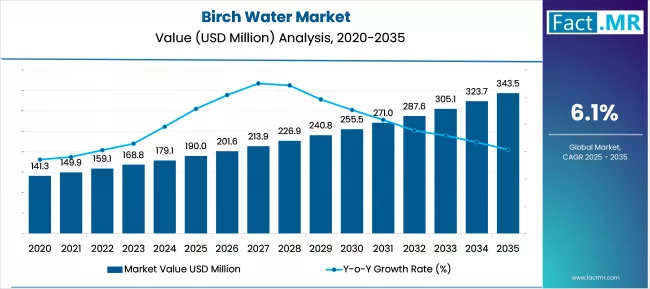
The birch water market’s growth is further reinforced by the rising global trend toward healthy lifestyles and natural nutrition. Consumers are increasingly seeking beverages that provide hydration while offering additional functional benefits such as vitamins, minerals, and antioxidants. Birch water, derived from the sap of birch trees, naturally contains minerals like potassium, calcium, magnesium, and zinc, as well as bioactive compounds that support cellular health and antioxidant activity. These inherent nutritional benefits position birch water as a premium alternative to conventional sugar-sweetened beverages, soft drinks, and artificially flavored waters.
Millennial and Gen Z consumers, in particular, are driving demand for plant-based and sustainable beverage options. The clean-label movement, emphasizing transparency in sourcing, minimal processing, and absence of synthetic additives, aligns closely with birch water’s natural profile. Brands are increasingly highlighting the sustainability of birch water harvesting, as the process does not harm trees and supports forest conservation efforts, making the product attractive to environmentally conscious buyers. This eco-friendly narrative strengthens brand positioning and can justify premium pricing in competitive beverage markets.
Distribution expansion is another key driver of market growth. Health-focused retail channels such as organic supermarkets, wellness stores, and specialty beverage shops are increasingly stocking birch water, often alongside other functional beverages like coconut water, aloe vera drinks, and herbal infusions. Online platforms and direct-to-consumer subscription models are also enabling brands to reach niche audiences in urban and semi-urban regions where wellness-oriented consumption is rising. Seasonal promotions, influencer marketing, and educational campaigns about the unique benefits of birch sap further stimulate consumer adoption and awareness.
Innovation in product variants is expected to accelerate market expansion. Manufacturers are exploring flavored birch waters, fortified options with added vitamins or electrolytes, and blends with other natural ingredients such as fruits or herbal extracts. Such innovations enhance taste appeal and broaden the target consumer base, from athletes seeking natural hydration to wellness-conscious professionals looking for convenient, nutrient-rich beverages.
North America and Europe dominate the birch water market due to high health consciousness, disposable income, and established retail infrastructure. However, emerging markets in Asia-Pacific and Latin America are showing promising growth prospects, fueled by increasing urbanization, exposure to Western dietary trends, and rising interest in functional beverages. Overall, the birch water market is poised for steady, sustained growth, driven by health trends, sustainability awareness, and expanding distribution channels, establishing it as a significant segment within the broader functional beverage industry.
Between 2025 and 2030, the birch water market is projected to expand from USD 210.0 million to USD 270.0 million, resulting in a value increase of USD 60.0 million, which represents 46.2% of the total forecast growth for the decade. This phase of development will be shaped by increasing health consciousness among consumers, growing interest in functional natural beverages, and expanding distribution through mainstream retail channels. Beverage manufacturers and natural product companies are expanding their birch water capabilities to address the growing demand for innovative and health-supporting hydration solutions.
Birch Water Market Key Takeaways
| Metric | Value |
|---|---|
| Estimated Value in (2025E) | USD 210.0 million |
| Forecast Value in (2035F) | USD 340.0 million |
| Forecast CAGR (2025 to 2035) | 4.9% |
From 2030 to 2035, the market is forecast to grow from USD 270.0 million to USD 340.0 million, adding another USD 70.0 million, which constitutes 53.8% of the overall ten-year expansion. This period is expected to be characterized by the expansion of flavored product varieties, development of functional ingredient combinations, and growth of sustainable packaging solutions and premium positioning. The growing adoption of wellness lifestyle trends and natural product preferences will drive demand for birch water products with enhanced functionality and authentic natural positioning.
Between 2020 and 2025, the birch water market experienced significant growth, driven by increasing consumer discovery of Nordic wellness traditions and growing recognition of birch water as a natural alternative to conventional sports drinks and flavored waters. The market developed as health-conscious consumers and wellness enthusiasts recognized the potential for birch water to provide natural hydration, functional benefits, and authentic connection to traditional Nordic health practices while supporting sustainable and natural lifestyle choices.
Why is the Birch Water Market Growing?
Market expansion is being supported by the increasing consumer interest in natural and functional beverages driven by health consciousness and wellness trends, alongside the corresponding need for authentic natural hydration solutions that can provide functional benefits, sustainable sourcing, and clean label characteristics across various health-conscious consumer segments and wellness applications.
Modern beverage manufacturers and natural product companies are increasingly focused on implementing birch water solutions that can address hydration needs, support wellness objectives, and provide differentiated natural beverage experiences while maintaining authenticity and sustainability credentials.
The growing emphasis on natural wellness and sustainable consumption is driving demand for birch water that can support healthy hydration, enable natural lifestyle choices, and ensure comprehensive environmental responsibility.
Beverage manufacturers' preference for products that combine natural authenticity with functional benefits and sustainability credentials is creating opportunities for innovative birch water implementations.
The rising influence of Nordic wellness trends and traditional health practices is also contributing to increased adoption of birch water that can provide superior natural benefits without compromising taste or environmental impact.
Segmental Analysis
The market is segmented by flavor, packaging, and distribution channel. By flavor, the market is divided into original and flavored varieties. Based on packaging, the market is categorized into bottles, cartons, and cans. By distribution channel, the market is segmented into retail, online, and foodservice channels.
By Flavor, the Original Segment Leads the Market
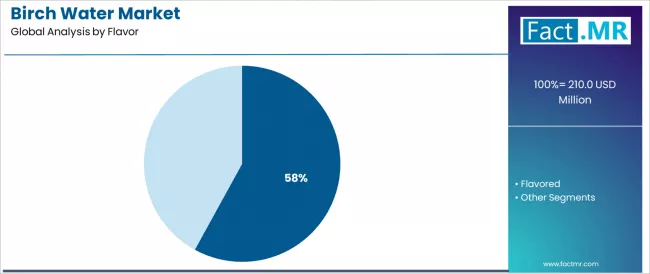
The original flavor segment is projected to maintain its leading position in the birch water market in 2025 with a 58.0% market share, reaffirming its role as the preferred flavor profile for birch water consumption and authentic natural beverage experiences.
Beverage manufacturers and consumers increasingly utilize original birch water for its pure taste characteristics, natural authenticity, and proven effectiveness in delivering traditional Nordic wellness benefits while maintaining product integrity and clean label appeal.
Original flavor's proven authenticity and consumer acceptance directly address market requirements for natural beverage experiences and established wellness traditions across diverse health-conscious consumer segments and wellness applications.
This flavor segment forms the foundation of modern birch water consumption, as it represents the flavor with the greatest contribution to authentic positioning and established consumer recognition across multiple retail channels and wellness contexts. Natural beverage industry investments in original flavor preservation continue to strengthen adoption among producers and consumers.
With consumer preferences requiring authentic natural experiences, original birch water aligns with both wellness objectives and natural authenticity requirements, making it the central component of comprehensive birch water market strategies.
By Packaging, the Bottles Segment Dominates Market Demand
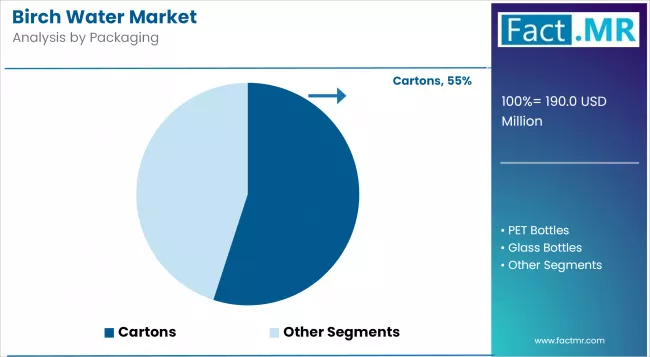
Bottle packaging is projected to represent the largest share of birch water demand in 2025 with a 66.0% market share, underscoring its critical role as the primary packaging format for birch water distribution across retail channels, premium positioning, and consumer convenience applications.
Manufacturers prefer bottle packaging for birch water due to superior product protection capabilities, premium presentation benefits, and ability to maintain product quality while supporting brand positioning and shelf appeal. Positioned as essential packaging for natural beverages, bottles offer both product preservation advantages and consumer accessibility benefits.
The segment is supported by continuous innovation in sustainable packaging materials and the growing availability of eco-friendly bottle options that enable superior environmental performance with enhanced consumer appeal and sustainability positioning.
Beverage manufacturers are investing in comprehensive packaging sustainability programs to support increasingly environmentally conscious birch water offerings and consumer environmental responsibility requirements.
As natural beverage consumption increases and sustainability standards advance, the bottles packaging segment will continue to dominate the market while supporting advanced sustainability strategies and consumer convenience optimization.
By Distribution Channel, the Retail Segment Leads Market Access
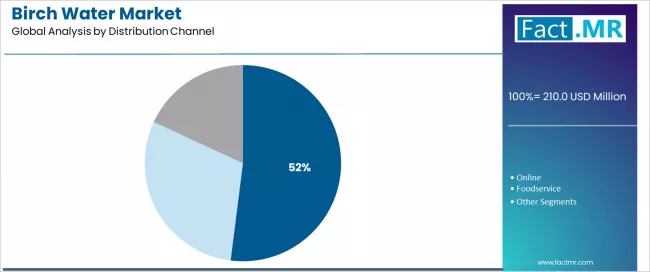
The retail distribution channel segment is projected to maintain its leading position in the birch water market in 2025 with a 52.0% market share, reflecting the importance of traditional retail channels in making natural beverages accessible to mainstream consumers. Retail channels provide visibility, product education, and convenient access that support birch water adoption across diverse consumer segments.
What are the Drivers, Restraints, and Key Trends of the Birch Water Market?
The birch water market is advancing steadily due to increasing consumer interest in natural and functional beverages driven by health consciousness and wellness lifestyle trends, alongside growing demand for sustainable and authentic natural products that provide hydration benefits, functional characteristics, and environmental responsibility across various health-focused consumer applications.
The market faces challenges, including limited consumer awareness in some regions, seasonal availability constraints for raw material sourcing, and competition from established functional beverage categories. Innovation in flavor development and sustainable sourcing practices continues to influence product accessibility and market expansion patterns.
Expansion of Health and Wellness Consumer Trends
The growing focus on health and wellness is driving demand for birch water that can provide natural hydration, functional benefits, and authentic wellness experiences through traditional Nordic health practices and natural ingredient sourcing. Health-conscious consumers require natural beverage alternatives that deliver superior wellness benefits across multiple health parameters while maintaining natural authenticity and environmental responsibility.
Beverage brands are increasingly recognizing the competitive advantages of birch water positioning for wellness market development and natural product differentiation, creating opportunities for specialized products designed for specific wellness applications and health-conscious consumer segments.
Integration of Sustainable and Ethical Sourcing
Modern birch water manufacturers are incorporating sustainable harvesting practices and ethical sourcing methods to enhance environmental performance, support forest conservation, and ensure comprehensive sustainability objectives through responsible tree tapping, seasonal harvesting, and ecosystem preservation.
Leading companies are developing sustainable sourcing partnerships, implementing forest stewardship practices, and advancing harvesting technologies that minimize environmental impact while maintaining product quality and supply reliability.
These practices improve sustainability credentials while enabling new market opportunities, including eco-conscious consumers, sustainable retail partnerships, and environmentally responsible brand positioning.
Development of Functional and Flavored Innovations
The expansion of functional beverage trends and flavor innovation is driving demand for enhanced birch water products with added functional ingredients, natural flavor combinations, and specialized health-targeting formulations that address specific consumer wellness needs and taste preferences.
These advanced product developments require specialized formulation capabilities and quality control systems that maintain natural authenticity while enhancing functionality and appeal, creating premium market segments with differentiated value propositions.
Manufacturers are investing in product development and flavor innovation to serve emerging wellness applications while supporting innovation in natural functional beverages and consumer preference optimization.
Analysis of the Birch Water Market by Key Countries
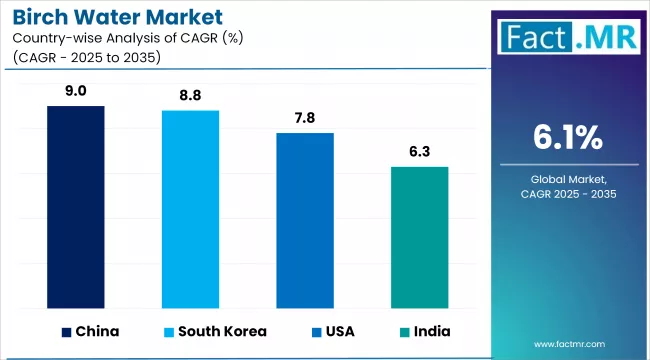
| Country | CAGR (2025-2035) |
|---|---|
| USA | 5.6% |
| Mexico | 5.2% |
| Germany | 4.8% |
| France | 4.7% |
| UK | 4.5% |
| South Korea | 4.2% |
| Japan | 4.0% |
The birch water market is experiencing solid growth globally, with the USA leading at a 5.6% CAGR through 2035, driven by strong natural beverage market development, growing health consciousness, and increasing consumer interest in Nordic wellness traditions supporting birch water adoption. Mexico follows at 5.2%, supported by expanding health awareness, growing natural product appreciation, and increasing availability of international wellness beverages.
Germany shows growth at 4.8%, emphasizing natural product quality, sustainable consumption, and health-conscious beverage choices. France demonstrates 4.7% growth, supported by wellness lifestyle trends, natural product appreciation, and premium beverage consumption.
The UK records 4.5%, focusing on health optimization trends, natural beverage innovation, and wellness-oriented consumption. South Korea exhibits 4.2% growth, emphasizing wellness lifestyle adoption and premium natural products. Japan shows 4.0% growth, supported by health consciousness and quality natural beverage preferences.
USA Leads Global Market Growth with Natural Beverage Innovation
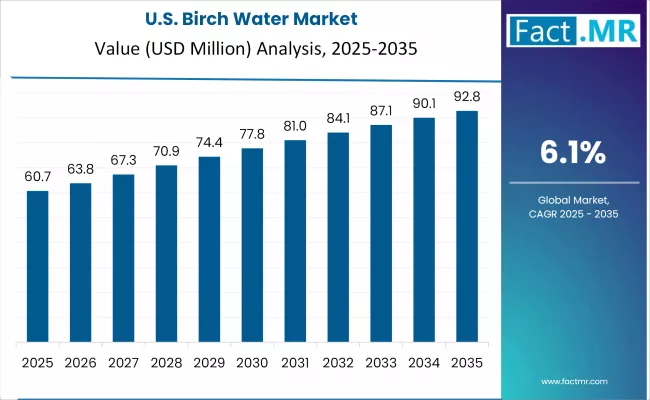
Revenue from birch water in the USA is projected to exhibit strong growth with a CAGR of 5.6% through 2035, driven by extensive natural beverage market development and rapidly growing consumer interest in Nordic wellness traditions supporting birch water adoption among health-conscious consumers, wellness enthusiasts, and natural product seekers. The country's established functional beverage infrastructure and increasing focus on natural health solutions are creating substantial demand for birch water solutions. Major natural beverage companies and wellness brands are establishing comprehensive product development capabilities to serve both domestic markets and natural product opportunities.
- Strong health consciousness and natural product trends are driving demand for birch water throughout health food stores, natural retailers, and premium grocery chains across urban markets, wellness communities, and health-focused consumer segments.
- Growing Nordic wellness interest and functional beverage consumption are supporting the rapid adoption of birch water among consumers seeking authentic natural hydration, traditional wellness benefits, and sustainable beverage alternatives for active lifestyles.
Mexico Demonstrates Strong Market Potential with Health Awareness Growth
Revenue from birch water in Mexico is expanding at a CAGR of 5.2%, supported by the country's expanding health awareness, growing natural product appreciation, and increasing consumer education about international wellness beverages and functional hydration alternatives. The country's evolving health consciousness and wellness market development are driving demand for natural birch water products throughout urban centers and health-conscious consumer communities. Leading natural beverage importers and wellness brands are establishing comprehensive distribution networks to address growing demand for innovative natural hydration solutions.
- Rising health awareness and expanding wellness culture are creating opportunities for birch water adoption across health food retailers, premium grocery stores, and wellness centers in major urban markets and health-conscious communities.
- Growing natural product interest and international wellness trend adoption are driving uptake of birch water products among consumers seeking authentic natural beverages, functional hydration, and sustainable wellness solutions for healthy lifestyles.
Germany Demonstrates Natural Excellence with Sustainability Leadership
Revenue from birch water in Germany is expanding at a CAGR of 4.8%, driven by the country's emphasis on natural product quality, sustainable consumption practices, and comprehensive approach to health-conscious beverage choices supporting authentic natural beverage adoption. Germany's environmental consciousness and natural product standards are driving demand for sustainable birch water solutions. Leading natural beverage importers and organic retailers are establishing comprehensive quality programs for authentic natural beverages.
- Advanced natural product standards and consumer preference for sustainable beverages are creating demand for premium birch water products among environmentally conscious consumers seeking authentic natural hydration and sustainable consumption choices.
- Strong sustainability focus and organic market development are supporting the adoption of ethically sourced birch water across organic retailers, health food stores, and environmentally responsible retail channels throughout major urban and environmental regions.
France Focuses on Wellness Excellence and Premium Natural Products
Revenue from birch water in France is expanding at a CAGR of 4.7%, driven by the country's wellness lifestyle trends, natural product appreciation, and sophisticated approach to premium beverage consumption supporting birch water integration into French wellness and natural health practices. France's wellness culture and premium product focus are supporting investment in natural beverage positioning. Major wellness brands and premium retailers are establishing comprehensive innovation programs incorporating birch water with French wellness approaches.
- Advanced wellness consciousness and consumer preference for premium natural products are creating demand for birch water throughout specialty beverage retailers, wellness centers, and premium grocery chains serving health-focused consumer segments.
- Strong wellness lifestyle trends and natural product sophistication are driving the adoption of premium birch water products across wellness-oriented retail channels, health spas, and sophisticated natural product venues throughout major metropolitan and wellness regions.
UK Shows Market Leadership with Health Optimization Focus
Revenue from birch water in the UK is expanding at a CAGR of 4.5%, supported by the country's health optimization trends, natural beverage innovation, and growing interest in wellness-oriented consumption and functional hydration alternatives. The UK's wellness market maturity and natural product acceptance are driving demand for innovative birch water solutions. Leading natural beverage companies and health retailers are investing in natural product development and wellness positioning for health-conscious consumers.
- Advanced health optimization trends and consumer interest in natural wellness are creating opportunities for birch water products throughout health retailers, wellness stores, and premium grocery chains serving health-conscious consumer segments.
- Strong natural beverage market and wellness focus are driving the adoption of birch water across functional beverage sections, wellness-oriented retail channels, and health-focused consumption occasions targeting natural wellness consumers.
South Korea Demonstrates Wellness Leadership with Premium Health Focus
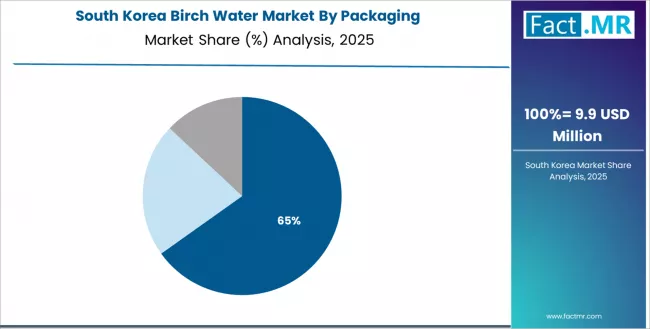
Revenue from birch water in South Korea is expanding at a CAGR of 4.2%, supported by the country's wellness lifestyle adoption, growing appreciation for premium natural products, and strong emphasis on health optimization and traditional wellness practices supporting advanced natural beverage adoption. The nation's health consciousness and premium product preferences are driving demand for sophisticated birch water solutions. Leading wellness companies are investing extensively in premium natural product development and health market expansion.
- Advanced wellness culture and premium health product trends are creating demand for birch water throughout premium health stores, wellness centers, and luxury retail outlets serving health-conscious consumer segments.
- Strong traditional wellness integration and premium product focus are supporting the adoption of birch water designed for health optimization, wellness lifestyle, and premium natural consumption across diverse consumer demographics and wellness applications.
Japan Shows Premium Focus with Natural Health Applications
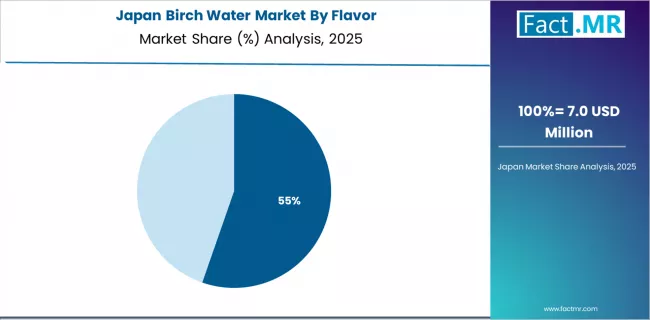
Revenue from birch water in Japan is expanding at a CAGR of 4.0%, supported by the country's health consciousness, quality natural beverage preferences, and strong emphasis on authentic natural products and traditional wellness practices supporting birch water adoption for health maintenance. Japan's quality focus and health consciousness are driving demand for premium birch water products. Leading health beverage companies are investing in specialized capabilities for quality natural beverages and authentic wellness applications.
- Advanced health consciousness and natural product appreciation are creating opportunities for birch water throughout premium health retailers, specialty beverage stores, and quality-focused retail channels serving health-conscious consumer segments.
- Strong quality standards and natural wellness focus are driving adoption of premium birch water products meeting Japanese consumer expectations for authenticity, natural purity, and comprehensive health support across diverse age groups and wellness objectives.
Europe Market Split by Country
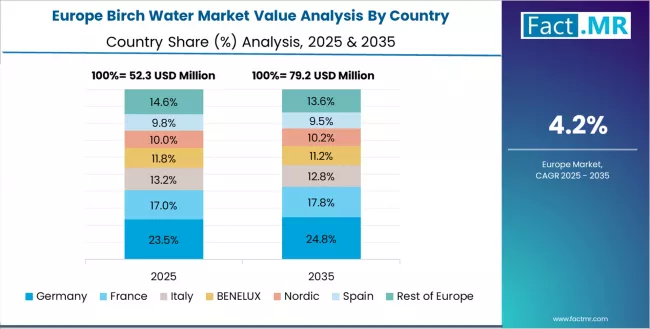
The birch water market in Europe is projected to grow from USD 85.0 million in 2025 to USD 135.0 million by 2035, registering a CAGR of 4.7% over the forecast period. Germany is expected to maintain leadership with a 28.2% market share in 2025, moderating to 27.9% by 2035, supported by natural product quality emphasis, sustainable consumption practices, and comprehensive environmental consciousness.
France follows with 22.4% in 2025, projected to reach 22.6% by 2035, driven by wellness lifestyle trends, premium natural product appreciation, and sophisticated beverage consumption culture. The United Kingdom holds 21.2% in 2025, expected to reach 21.4% by 2035 due to health optimization trends and natural beverage market development. Italy commands 14.1% in 2025, rising to 14.2% by 2035, while Spain accounts for 8.2% in 2025, reaching 8.3% by 2035. The Rest of Europe region is anticipated to hold 5.9% in 2025 and 5.6% by 2035, reflecting steady natural beverage market development in Nordic countries and emerging wellness markets in Eastern European countries where birch water has traditional cultural significance.
Competitive Landscape of the Birch Water Market
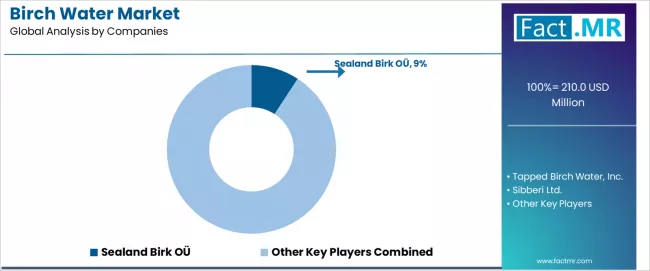
The birch water market is characterized by competition among specialized birch water producers, natural beverage companies, and emerging wellness brands. Companies are investing in sustainable sourcing technology development, product innovation and differentiation, premium positioning strategies, and distribution network expansion to deliver authentic, high-quality, and accessible birch water solutions. Innovation in flavor development, functional enhancement, and sustainable packaging is central to strengthening market position and competitive advantage.
Sealand Birk leads the market with a 9.2% share, offering comprehensive birch water solutions with focus on Nordic authenticity, sustainable harvesting practices, and premium natural positioning across diverse retail and wellness applications. The company continues investing in sustainable sourcing capabilities and product development while expanding international distribution and brand awareness programs.
Tapped Birch Water provides artisanal natural beverage solutions with emphasis on purity and traditional methods. Sibberi specializes in premium natural drinks with wellness positioning. Byarozavik focuses on authentic Eastern European birch water traditions. Treo offers Scandinavian heritage and natural purity. Nature's Own emphasizes natural authenticity and health benefits.
Key Players in the Birch Water Market
- Sealand Birk OÜ
- Tapped Birch Water, Inc.
- Sibberi Ltd.
- Byarozavik
- Treo Beverages
- Nature's Own Birch Water
- Alaska Birch Syrup Company
- Nordic Koivu
- BelSeva
- Sapsa Nutrition
Scope of the Report
| Items | Values |
|---|---|
| Quantitative Units (2025) | USD 210.0 Million |
| Flavor | Original, Flavored |
| Packaging | Bottles, Cartons, Cans |
| Distribution Channel | Retail, Online, Foodservice |
| Regions Covered | North America, Europe, Asia-Pacific, Latin America, Middle East & Africa |
| Countries Covered | USA, Mexico, Germany, France, UK, Japan, South Korea, and 40+ countries |
| Key Companies Profiled | Sealand Birk, Tapped Birch Water, Sibberi, Byarozavik, Treo, Nature's Own |
| Additional Attributes | Dollar sales by flavor and packaging, regional demand trends, competitive landscape, sustainable sourcing development, natural wellness positioning, flavor innovation, and consumer education optimization |
Birch Water Market by Segments
-
Flavor :
- Original
- Flavored
-
Packaging :
- Bottles
- Cartons
- Cans
-
Distribution Channel :
- Retail
- Online
- Foodservice
-
Region :
-
North America
- United States
- Canada
- Mexico
-
Europe
- Germany
- United Kingdom
- France
- Italy
- Spain
- Netherlands
- Rest of Europe
-
Asia-Pacific
- Japan
- South Korea
- China
- India
- Australia
- Rest of Asia-Pacific
-
Latin America
- Brazil
- Argentina
- Rest of Latin America
-
Middle East & Africa
- Kingdom of Saudi Arabia
- South Africa
- Rest of Middle East & Africa
-
Table of Content
- Executive Summary
- Global Market Outlook
- Demand to side Trends
- Supply to side Trends
- Technology Roadmap Analysis
- Analysis and Recommendations
- Market Overview
- Market Coverage / Taxonomy
- Market Definition / Scope / Limitations
- Market Background
- Market Dynamics
- Drivers
- Restraints
- Opportunity
- Trends
- Scenario Forecast
- Demand in Optimistic Scenario
- Demand in Likely Scenario
- Demand in Conservative Scenario
- Opportunity Map Analysis
- Product Life Cycle Analysis
- Supply Chain Analysis
- Investment Feasibility Matrix
- Value Chain Analysis
- PESTLE and Porter’s Analysis
- Regulatory Landscape
- Regional Parent Market Outlook
- Production and Consumption Statistics
- Import and Export Statistics
- Market Dynamics
- Global Market Analysis 2020 to 2024 and Forecast, 2025 to 2035
- Historical Market Size Value (USD Million) Analysis, 2020 to 2024
- Current and Future Market Size Value (USD Million) Projections, 2025 to 2035
- Y to o to Y Growth Trend Analysis
- Absolute $ Opportunity Analysis
- Global Market Pricing Analysis 2020 to 2024 and Forecast 2025 to 2035
- Global Market Analysis 2020 to 2024 and Forecast 2025 to 2035, By Flavor
- Introduction / Key Findings
- Historical Market Size Value (USD Million) Analysis By Flavor , 2020 to 2024
- Current and Future Market Size Value (USD Million) Analysis and Forecast By Flavor , 2025 to 2035
- Original
- Flavored
- Y to o to Y Growth Trend Analysis By Flavor , 2020 to 2024
- Absolute $ Opportunity Analysis By Flavor , 2025 to 2035
- Global Market Analysis 2020 to 2024 and Forecast 2025 to 2035, By Packaging
- Introduction / Key Findings
- Historical Market Size Value (USD Million) Analysis By Packaging, 2020 to 2024
- Current and Future Market Size Value (USD Million) Analysis and Forecast By Packaging, 2025 to 2035
- Bottles
- Cartons
- Cans
- Y to o to Y Growth Trend Analysis By Packaging, 2020 to 2024
- Absolute $ Opportunity Analysis By Packaging, 2025 to 2035
- Global Market Analysis 2020 to 2024 and Forecast 2025 to 2035, By Distribution Channel
- Introduction / Key Findings
- Historical Market Size Value (USD Million) Analysis By Distribution Channel, 2020 to 2024
- Current and Future Market Size Value (USD Million) Analysis and Forecast By Distribution Channel, 2025 to 2035
- Retail
- Online
- Foodservice
- Y to o to Y Growth Trend Analysis By Distribution Channel, 2020 to 2024
- Absolute $ Opportunity Analysis By Distribution Channel, 2025 to 2035
- Global Market Analysis 2020 to 2024 and Forecast 2025 to 2035, By Region
- Introduction
- Historical Market Size Value (USD Million) Analysis By Region, 2020 to 2024
- Current Market Size Value (USD Million) Analysis and Forecast By Region, 2025 to 2035
- North America
- Latin America
- Western Europe
- Eastern Europe
- East Asia
- South Asia and Pacific
- Middle East & Africa
- Market Attractiveness Analysis By Region
- North America Market Analysis 2020 to 2024 and Forecast 2025 to 2035, By Country
- Historical Market Size Value (USD Million) Trend Analysis By Market Taxonomy, 2020 to 2024
- Market Size Value (USD Million) Forecast By Market Taxonomy, 2025 to 2035
- By Country
- USA
- Canada
- Mexico
- By Flavor
- By Packaging
- By Distribution Channel
- By Country
- Market Attractiveness Analysis
- By Country
- By Flavor
- By Packaging
- By Distribution Channel
- Key Takeaways
- Latin America Market Analysis 2020 to 2024 and Forecast 2025 to 2035, By Country
- Historical Market Size Value (USD Million) Trend Analysis By Market Taxonomy, 2020 to 2024
- Market Size Value (USD Million) Forecast By Market Taxonomy, 2025 to 2035
- By Country
- Brazil
- Chile
- Rest of Latin America
- By Flavor
- By Packaging
- By Distribution Channel
- By Country
- Market Attractiveness Analysis
- By Country
- By Flavor
- By Packaging
- By Distribution Channel
- Key Takeaways
- Western Europe Market Analysis 2020 to 2024 and Forecast 2025 to 2035, By Country
- Historical Market Size Value (USD Million) Trend Analysis By Market Taxonomy, 2020 to 2024
- Market Size Value (USD Million) Forecast By Market Taxonomy, 2025 to 2035
- By Country
- Germany
- UK
- Italy
- Spain
- France
- Nordic
- BENELUX
- Rest of Western Europe
- By Flavor
- By Packaging
- By Distribution Channel
- By Country
- Market Attractiveness Analysis
- By Country
- By Flavor
- By Packaging
- By Distribution Channel
- Key Takeaways
- Eastern Europe Market Analysis 2020 to 2024 and Forecast 2025 to 2035, By Country
- Historical Market Size Value (USD Million) Trend Analysis By Market Taxonomy, 2020 to 2024
- Market Size Value (USD Million) Forecast By Market Taxonomy, 2025 to 2035
- By Country
- Russia
- Poland
- Hungary
- Balkan & Baltic
- Rest of Eastern Europe
- By Flavor
- By Packaging
- By Distribution Channel
- By Country
- Market Attractiveness Analysis
- By Country
- By Flavor
- By Packaging
- By Distribution Channel
- Key Takeaways
- East Asia Market Analysis 2020 to 2024 and Forecast 2025 to 2035, By Country
- Historical Market Size Value (USD Million) Trend Analysis By Market Taxonomy, 2020 to 2024
- Market Size Value (USD Million) Forecast By Market Taxonomy, 2025 to 2035
- By Country
- China
- Japan
- South Korea
- By Flavor
- By Packaging
- By Distribution Channel
- By Country
- Market Attractiveness Analysis
- By Country
- By Flavor
- By Packaging
- By Distribution Channel
- Key Takeaways
- South Asia and Pacific Market Analysis 2020 to 2024 and Forecast 2025 to 2035, By Country
- Historical Market Size Value (USD Million) Trend Analysis By Market Taxonomy, 2020 to 2024
- Market Size Value (USD Million) Forecast By Market Taxonomy, 2025 to 2035
- By Country
- India
- ASEAN
- Australia & New Zealand
- Rest of South Asia and Pacific
- By Flavor
- By Packaging
- By Distribution Channel
- By Country
- Market Attractiveness Analysis
- By Country
- By Flavor
- By Packaging
- By Distribution Channel
- Key Takeaways
- Middle East & Africa Market Analysis 2020 to 2024 and Forecast 2025 to 2035, By Country
- Historical Market Size Value (USD Million) Trend Analysis By Market Taxonomy, 2020 to 2024
- Market Size Value (USD Million) Forecast By Market Taxonomy, 2025 to 2035
- By Country
- Kingdom of Saudi Arabia
- Other GCC Countries
- Turkiye
- South Africa
- Other African Union
- Rest of Middle East & Africa
- By Flavor
- By Packaging
- By Distribution Channel
- By Country
- Market Attractiveness Analysis
- By Country
- By Flavor
- By Packaging
- By Distribution Channel
- Key Takeaways
- Key Countries Market Analysis
- USA
- Pricing Analysis
- Market Share Analysis, 2024
- By Flavor
- By Packaging
- By Distribution Channel
- Canada
- Pricing Analysis
- Market Share Analysis, 2024
- By Flavor
- By Packaging
- By Distribution Channel
- Mexico
- Pricing Analysis
- Market Share Analysis, 2024
- By Flavor
- By Packaging
- By Distribution Channel
- Brazil
- Pricing Analysis
- Market Share Analysis, 2024
- By Flavor
- By Packaging
- By Distribution Channel
- Chile
- Pricing Analysis
- Market Share Analysis, 2024
- By Flavor
- By Packaging
- By Distribution Channel
- Germany
- Pricing Analysis
- Market Share Analysis, 2024
- By Flavor
- By Packaging
- By Distribution Channel
- UK
- Pricing Analysis
- Market Share Analysis, 2024
- By Flavor
- By Packaging
- By Distribution Channel
- Italy
- Pricing Analysis
- Market Share Analysis, 2024
- By Flavor
- By Packaging
- By Distribution Channel
- Spain
- Pricing Analysis
- Market Share Analysis, 2024
- By Flavor
- By Packaging
- By Distribution Channel
- France
- Pricing Analysis
- Market Share Analysis, 2024
- By Flavor
- By Packaging
- By Distribution Channel
- India
- Pricing Analysis
- Market Share Analysis, 2024
- By Flavor
- By Packaging
- By Distribution Channel
- ASEAN
- Pricing Analysis
- Market Share Analysis, 2024
- By Flavor
- By Packaging
- By Distribution Channel
- Australia & New Zealand
- Pricing Analysis
- Market Share Analysis, 2024
- By Flavor
- By Packaging
- By Distribution Channel
- China
- Pricing Analysis
- Market Share Analysis, 2024
- By Flavor
- By Packaging
- By Distribution Channel
- Japan
- Pricing Analysis
- Market Share Analysis, 2024
- By Flavor
- By Packaging
- By Distribution Channel
- South Korea
- Pricing Analysis
- Market Share Analysis, 2024
- By Flavor
- By Packaging
- By Distribution Channel
- Russia
- Pricing Analysis
- Market Share Analysis, 2024
- By Flavor
- By Packaging
- By Distribution Channel
- Poland
- Pricing Analysis
- Market Share Analysis, 2024
- By Flavor
- By Packaging
- By Distribution Channel
- Hungary
- Pricing Analysis
- Market Share Analysis, 2024
- By Flavor
- By Packaging
- By Distribution Channel
- Kingdom of Saudi Arabia
- Pricing Analysis
- Market Share Analysis, 2024
- By Flavor
- By Packaging
- By Distribution Channel
- Turkiye
- Pricing Analysis
- Market Share Analysis, 2024
- By Flavor
- By Packaging
- By Distribution Channel
- South Africa
- Pricing Analysis
- Market Share Analysis, 2024
- By Flavor
- By Packaging
- By Distribution Channel
- USA
- Market Structure Analysis
- Competition Dashboard
- Competition Benchmarking
- Market Share Analysis of Top Players
- By Regional
- By Flavor
- By Packaging
- By Distribution Channel
- Competition Analysis
- Competition Deep Dive
- Sealand Birk OÜ
- Overview
- Product Portfolio
- Profitability by Market Segments (Product/Age /Sales Channel/Region)
- Sales Footprint
- Strategy Overview
- Marketing Strategy
- Product Strategy
- Channel Strategy
- Tapped Birch Water, Inc.
- Sibberi Ltd.
- Byarozavik
- Treo Beverages
- Nature's Own Birch Water
- Alaska Birch Syrup Company
- Nordic Koivu
- BelSeva
- Sapsa Nutrition
- Sealand Birk OÜ
- Competition Deep Dive
- Assumptions & Acronyms Used
- Research Methodology
List Of Table
- Table 1: Global Market Value (USD Million) Forecast by Region, 2020 to 2035
- Table 2: Global Market Value (USD Million) Forecast by Flavor , 2020 to 2035
- Table 3: Global Market Value (USD Million) Forecast by Packaging, 2020 to 2035
- Table 4: Global Market Value (USD Million) Forecast by Distribution Channel, 2020 to 2035
- Table 5: North America Market Value (USD Million) Forecast by Country, 2020 to 2035
- Table 6: North America Market Value (USD Million) Forecast by Flavor , 2020 to 2035
- Table 7: North America Market Value (USD Million) Forecast by Packaging, 2020 to 2035
- Table 8: North America Market Value (USD Million) Forecast by Distribution Channel, 2020 to 2035
- Table 9: Latin America Market Value (USD Million) Forecast by Country, 2020 to 2035
- Table 10: Latin America Market Value (USD Million) Forecast by Flavor , 2020 to 2035
- Table 11: Latin America Market Value (USD Million) Forecast by Packaging, 2020 to 2035
- Table 12: Latin America Market Value (USD Million) Forecast by Distribution Channel, 2020 to 2035
- Table 13: Western Europe Market Value (USD Million) Forecast by Country, 2020 to 2035
- Table 14: Western Europe Market Value (USD Million) Forecast by Flavor , 2020 to 2035
- Table 15: Western Europe Market Value (USD Million) Forecast by Packaging, 2020 to 2035
- Table 16: Western Europe Market Value (USD Million) Forecast by Distribution Channel, 2020 to 2035
- Table 17: Eastern Europe Market Value (USD Million) Forecast by Country, 2020 to 2035
- Table 18: Eastern Europe Market Value (USD Million) Forecast by Flavor , 2020 to 2035
- Table 19: Eastern Europe Market Value (USD Million) Forecast by Packaging, 2020 to 2035
- Table 20: Eastern Europe Market Value (USD Million) Forecast by Distribution Channel, 2020 to 2035
- Table 21: East Asia Market Value (USD Million) Forecast by Country, 2020 to 2035
- Table 22: East Asia Market Value (USD Million) Forecast by Flavor , 2020 to 2035
- Table 23: East Asia Market Value (USD Million) Forecast by Packaging, 2020 to 2035
- Table 24: East Asia Market Value (USD Million) Forecast by Distribution Channel, 2020 to 2035
- Table 25: South Asia and Pacific Market Value (USD Million) Forecast by Country, 2020 to 2035
- Table 26: South Asia and Pacific Market Value (USD Million) Forecast by Flavor , 2020 to 2035
- Table 27: South Asia and Pacific Market Value (USD Million) Forecast by Packaging, 2020 to 2035
- Table 28: South Asia and Pacific Market Value (USD Million) Forecast by Distribution Channel, 2020 to 2035
- Table 29: Middle East & Africa Market Value (USD Million) Forecast by Country, 2020 to 2035
- Table 30: Middle East & Africa Market Value (USD Million) Forecast by Flavor , 2020 to 2035
- Table 31: Middle East & Africa Market Value (USD Million) Forecast by Packaging, 2020 to 2035
- Table 32: Middle East & Africa Market Value (USD Million) Forecast by Distribution Channel, 2020 to 2035
List Of Figures
- Figure 1: Global Market Pricing Analysis
- Figure 2: Global Market Value (USD Million) Forecast 2020-2035
- Figure 3: Global Market Value Share and BPS Analysis by Flavor , 2025 and 2035
- Figure 4: Global Market Y to o to Y Growth Comparison by Flavor , 2025-2035
- Figure 5: Global Market Attractiveness Analysis by Flavor
- Figure 6: Global Market Value Share and BPS Analysis by Packaging, 2025 and 2035
- Figure 7: Global Market Y to o to Y Growth Comparison by Packaging, 2025-2035
- Figure 8: Global Market Attractiveness Analysis by Packaging
- Figure 9: Global Market Value Share and BPS Analysis by Distribution Channel, 2025 and 2035
- Figure 10: Global Market Y to o to Y Growth Comparison by Distribution Channel, 2025-2035
- Figure 11: Global Market Attractiveness Analysis by Distribution Channel
- Figure 12: Global Market Value (USD Million) Share and BPS Analysis by Region, 2025 and 2035
- Figure 13: Global Market Y to o to Y Growth Comparison by Region, 2025-2035
- Figure 14: Global Market Attractiveness Analysis by Region
- Figure 15: North America Market Incremental Dollar Opportunity, 2025-2035
- Figure 16: Latin America Market Incremental Dollar Opportunity, 2025-2035
- Figure 17: Western Europe Market Incremental Dollar Opportunity, 2025-2035
- Figure 18: Eastern Europe Market Incremental Dollar Opportunity, 2025-2035
- Figure 19: East Asia Market Incremental Dollar Opportunity, 2025-2035
- Figure 20: South Asia and Pacific Market Incremental Dollar Opportunity, 2025-2035
- Figure 21: Middle East & Africa Market Incremental Dollar Opportunity, 2025-2035
- Figure 22: North America Market Value Share and BPS Analysis by Country, 2025 and 2035
- Figure 23: North America Market Value Share and BPS Analysis by Flavor , 2025 and 2035
- Figure 24: North America Market Y to o to Y Growth Comparison by Flavor , 2025-2035
- Figure 25: North America Market Attractiveness Analysis by Flavor
- Figure 26: North America Market Value Share and BPS Analysis by Packaging, 2025 and 2035
- Figure 27: North America Market Y to o to Y Growth Comparison by Packaging, 2025-2035
- Figure 28: North America Market Attractiveness Analysis by Packaging
- Figure 29: North America Market Value Share and BPS Analysis by Distribution Channel, 2025 and 2035
- Figure 30: North America Market Y to o to Y Growth Comparison by Distribution Channel, 2025-2035
- Figure 31: North America Market Attractiveness Analysis by Distribution Channel
- Figure 32: Latin America Market Value Share and BPS Analysis by Country, 2025 and 2035
- Figure 33: Latin America Market Value Share and BPS Analysis by Flavor , 2025 and 2035
- Figure 34: Latin America Market Y to o to Y Growth Comparison by Flavor , 2025-2035
- Figure 35: Latin America Market Attractiveness Analysis by Flavor
- Figure 36: Latin America Market Value Share and BPS Analysis by Packaging, 2025 and 2035
- Figure 37: Latin America Market Y to o to Y Growth Comparison by Packaging, 2025-2035
- Figure 38: Latin America Market Attractiveness Analysis by Packaging
- Figure 39: Latin America Market Value Share and BPS Analysis by Distribution Channel, 2025 and 2035
- Figure 40: Latin America Market Y to o to Y Growth Comparison by Distribution Channel, 2025-2035
- Figure 41: Latin America Market Attractiveness Analysis by Distribution Channel
- Figure 42: Western Europe Market Value Share and BPS Analysis by Country, 2025 and 2035
- Figure 43: Western Europe Market Value Share and BPS Analysis by Flavor , 2025 and 2035
- Figure 44: Western Europe Market Y to o to Y Growth Comparison by Flavor , 2025-2035
- Figure 45: Western Europe Market Attractiveness Analysis by Flavor
- Figure 46: Western Europe Market Value Share and BPS Analysis by Packaging, 2025 and 2035
- Figure 47: Western Europe Market Y to o to Y Growth Comparison by Packaging, 2025-2035
- Figure 48: Western Europe Market Attractiveness Analysis by Packaging
- Figure 49: Western Europe Market Value Share and BPS Analysis by Distribution Channel, 2025 and 2035
- Figure 50: Western Europe Market Y to o to Y Growth Comparison by Distribution Channel, 2025-2035
- Figure 51: Western Europe Market Attractiveness Analysis by Distribution Channel
- Figure 52: Eastern Europe Market Value Share and BPS Analysis by Country, 2025 and 2035
- Figure 53: Eastern Europe Market Value Share and BPS Analysis by Flavor , 2025 and 2035
- Figure 54: Eastern Europe Market Y to o to Y Growth Comparison by Flavor , 2025-2035
- Figure 55: Eastern Europe Market Attractiveness Analysis by Flavor
- Figure 56: Eastern Europe Market Value Share and BPS Analysis by Packaging, 2025 and 2035
- Figure 57: Eastern Europe Market Y to o to Y Growth Comparison by Packaging, 2025-2035
- Figure 58: Eastern Europe Market Attractiveness Analysis by Packaging
- Figure 59: Eastern Europe Market Value Share and BPS Analysis by Distribution Channel, 2025 and 2035
- Figure 60: Eastern Europe Market Y to o to Y Growth Comparison by Distribution Channel, 2025-2035
- Figure 61: Eastern Europe Market Attractiveness Analysis by Distribution Channel
- Figure 62: East Asia Market Value Share and BPS Analysis by Country, 2025 and 2035
- Figure 63: East Asia Market Value Share and BPS Analysis by Flavor , 2025 and 2035
- Figure 64: East Asia Market Y to o to Y Growth Comparison by Flavor , 2025-2035
- Figure 65: East Asia Market Attractiveness Analysis by Flavor
- Figure 66: East Asia Market Value Share and BPS Analysis by Packaging, 2025 and 2035
- Figure 67: East Asia Market Y to o to Y Growth Comparison by Packaging, 2025-2035
- Figure 68: East Asia Market Attractiveness Analysis by Packaging
- Figure 69: East Asia Market Value Share and BPS Analysis by Distribution Channel, 2025 and 2035
- Figure 70: East Asia Market Y to o to Y Growth Comparison by Distribution Channel, 2025-2035
- Figure 71: East Asia Market Attractiveness Analysis by Distribution Channel
- Figure 72: South Asia and Pacific Market Value Share and BPS Analysis by Country, 2025 and 2035
- Figure 73: South Asia and Pacific Market Value Share and BPS Analysis by Flavor , 2025 and 2035
- Figure 74: South Asia and Pacific Market Y to o to Y Growth Comparison by Flavor , 2025-2035
- Figure 75: South Asia and Pacific Market Attractiveness Analysis by Flavor
- Figure 76: South Asia and Pacific Market Value Share and BPS Analysis by Packaging, 2025 and 2035
- Figure 77: South Asia and Pacific Market Y to o to Y Growth Comparison by Packaging, 2025-2035
- Figure 78: South Asia and Pacific Market Attractiveness Analysis by Packaging
- Figure 79: South Asia and Pacific Market Value Share and BPS Analysis by Distribution Channel, 2025 and 2035
- Figure 80: South Asia and Pacific Market Y to o to Y Growth Comparison by Distribution Channel, 2025-2035
- Figure 81: South Asia and Pacific Market Attractiveness Analysis by Distribution Channel
- Figure 82: Middle East & Africa Market Value Share and BPS Analysis by Country, 2025 and 2035
- Figure 83: Middle East & Africa Market Value Share and BPS Analysis by Flavor , 2025 and 2035
- Figure 84: Middle East & Africa Market Y to o to Y Growth Comparison by Flavor , 2025-2035
- Figure 85: Middle East & Africa Market Attractiveness Analysis by Flavor
- Figure 86: Middle East & Africa Market Value Share and BPS Analysis by Packaging, 2025 and 2035
- Figure 87: Middle East & Africa Market Y to o to Y Growth Comparison by Packaging, 2025-2035
- Figure 88: Middle East & Africa Market Attractiveness Analysis by Packaging
- Figure 89: Middle East & Africa Market Value Share and BPS Analysis by Distribution Channel, 2025 and 2035
- Figure 90: Middle East & Africa Market Y to o to Y Growth Comparison by Distribution Channel, 2025-2035
- Figure 91: Middle East & Africa Market Attractiveness Analysis by Distribution Channel
- Figure 92: Global Market - Tier Structure Analysis
- Figure 93: Global Market - Company Share Analysis
- FAQs -
How big is the birch water market in 2025?
The global birch water market is estimated to be valued at USD 210.0 million in 2025.
What will be the size of birch water market in 2035?
The market size for the birch water market is projected to reach USD 340.0 million by 2035.
How much will be the birch water market growth between 2025 and 2035?
The birch water market is expected to grow at a 4.9% CAGR between 2025 and 2035.
What are the key product types in the birch water market?
The key product types in birch water market are original and flavored.
Which packaging segment to contribute significant share in the birch water market in 2025?
In terms of packaging, bottles segment to command 66.0% share in the birch water market in 2025.